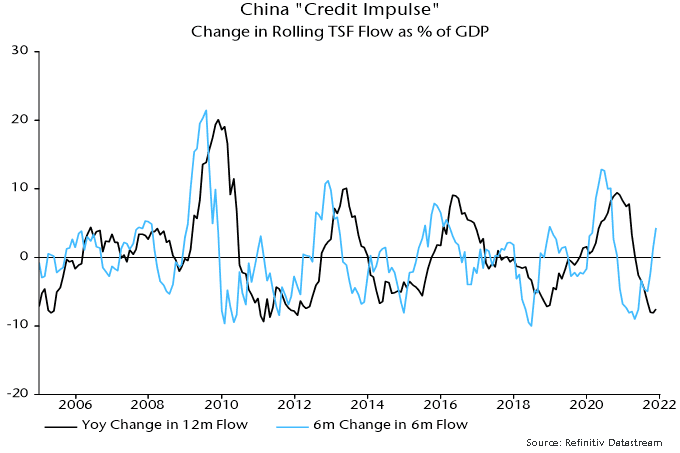Chinese monetary data mixed but hopeful

The expectation here has been that monetary policy easing since Q2 would result in a recovery in Chinese money growth into end-2021, in turn presaging better economic performance in 2022. The Evergrande default threatened to derail the scenario by triggering an endogenous tightening of credit conditions but November money data suggest that it remains on track.
A disappointing feature of the November numbers is that six-month growth of narrow money – as measured by “true” M1, which includes household as well as corporate demand deposits – appears* to have risen only slightly and has yet to break away decisively from a July low. Growth of the broader non-financial M2 measure and aggregate credit, however, increased further, in the former case to a 12-month high – see chart 1.
The forecasting approach here generally places greater weight on narrow than broad money for assessing directional changes in economic momentum. In China’s case, however, the signals from the measures have been similar; indeed, there are several examples of broad money growth leading narrow money growth at lows (e.g. 2008, 2011-12, 2018).
Sectoral data show a pick-up in M2 deposit growth of non-financial enterprises and continued solid household expansion – chart 2.
The judgement here is that the broad / narrow money divergence reflects current low economic confidence – the monetary position of households and firms has improved but this has yet to feed through to spending intentions and an associated switch out of time into demand deposits. The delayed transmission of money to the economy may reflect covid restrictions and property sector uncertainty but should proceed barring further negative shocks.
The case for optimism would be strengthened if three-month SHIBOR were to resume a decline following the latest cut in reserve requirement ratios. A July cut did not feed through to lower rates partly because the PBoC offset the impact in other money market operations – chart 3. Easing inflationary pressures – chart 4 – and property sector weakness suggest that the latest reduction is more likely to represent a genuine policy loosening.
Consensus views about Chinese economic prospects are influenced by the “credit impulse” – the change in the flow of credit expressed as a percentage of GDP. Previous research here analysing long-term G7 data found that the credit impulse underperformed real narrow money growth as a leading indicator, partly because it gave more false turning point signals. Regardless, some economists / strategists are likely to call attention to a bottoming-out of the 12-month impulse and a sharp recovery in the six-month version – chart 5.

*The household demand deposit component is currently estimated.
These are the views of the author at the time of publication and may differ from the views of other individuals/teams at Janus Henderson Investors. References made to individual securities do not constitute a recommendation to buy, sell or hold any security, investment strategy or market sector, and should not be assumed to be profitable. Janus Henderson Investors, its affiliated advisor, or its employees, may have a position in the securities mentioned.
Past performance does not predict future returns. The value of an investment and the income from it can fall as well as rise and you may not get back the amount originally invested.
The information in this article does not qualify as an investment recommendation.
Marketing Communication.
